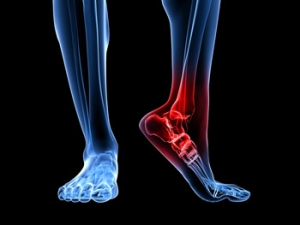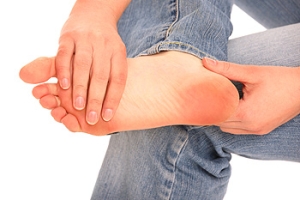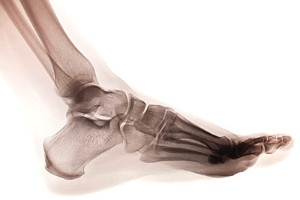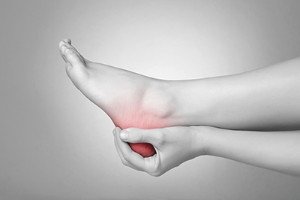Richfield (435) 896-6497
Ephraim (435) 283-4076

Falls Prevention
Elderly Americans are very susceptible to falls as they get older. Everyone experiences decreases in flexibility, balance, strength, and the senses as they age. This correlates to some eye-opening statistics. 1 in 4 Americans aged 65 and older fall each year. An elderly American is being treated for a fall in an emergency room every 11 seconds. In light of these striking statistics, one can see the importance of taking steps to prevent falls.
Finding an exercise program for the elderly is an excellent way to reduce the likelihood of falls. Look for an exercise program that improves strength and balance. Elderly people who live a more sedentary lifestyle, with little physical activity, are at an increased risk of falling. Wearing well-fitted footwear that provides good foot support and cushion will help prevent falls from poorly fitted shoes. Talking to a podiatrist about your susceptibility to falls and about inspecting your prescriptions will help to avoid any medication that could make falls more likely. Due to a decline in the senses among the elderly, having your eyes and hearing checked is recommended.
Around half of all falls occur in the household. Removing tripping hazards in the home and making it more accommodating to older persons can significantly reduce falls. Some notable household changes include increasing lighting around the house, installing grab bars in the shower and bathroom, and making sure the floor is clear of clutter. Other smart options include installing a shower chair, using rubber-bottomed rugs, and placing railings on both sides of stairwells.
Finally, discuss with a doctor and your family about your fear of falling. This will help to increase awareness among the population on the need for fall prevention. A lack of awareness on the matter, and a downplaying of importance are what increase the risks of falling. Following these tips can help to reduce the risk for yourself and your loved ones.
Ankle Sprains May Be Common Among Athletes
 Research has shown that ankle sprains are common among people who frequently participate in sporting activities. This is often the result of tearing or overstretching the ligaments in the ankle. Common symptoms of this type of injury may include severe swelling, pain, and it may be difficult to put weight on the ankle. Relief may be found when the affected foot is elevated, and this may help to alleviate a portion of the swelling. Additionally, it may be beneficial to wrap the ankle in an elastic bandage, and this can help to provide the support that is needed as the healing process takes place. If the activity is resumed that caused the sprain before the ankle has had a chance to completely heal the sprain may return, and ligaments may be scarred. If you have fallen or twisted your ankle, and think it may be sprained, it is suggested that you consult with a podiatrist who can diagnosis and treat this condition.
Research has shown that ankle sprains are common among people who frequently participate in sporting activities. This is often the result of tearing or overstretching the ligaments in the ankle. Common symptoms of this type of injury may include severe swelling, pain, and it may be difficult to put weight on the ankle. Relief may be found when the affected foot is elevated, and this may help to alleviate a portion of the swelling. Additionally, it may be beneficial to wrap the ankle in an elastic bandage, and this can help to provide the support that is needed as the healing process takes place. If the activity is resumed that caused the sprain before the ankle has had a chance to completely heal the sprain may return, and ligaments may be scarred. If you have fallen or twisted your ankle, and think it may be sprained, it is suggested that you consult with a podiatrist who can diagnosis and treat this condition.
Although ankle sprains are common, they aren’t always minor injuries. If you need your ankle injury looked at, contact Dr. Blake Zobell from Utah. Our doctor can provide the care you need to keep you pain-free and on your feet.
How Does an Ankle Sprain Occur?
Ankle sprains are the result of a tear in the ligaments within the ankle. These injuries may happen when you make a rapid shifting movement while your foot is planted. A less common way to sprain your ankle is when your ankle rolls inward while your foot turns outward.
What Are the Symptoms?
- Pain at the sight of the tear
- Bruising/Swelling
- Ankle area is tender to touch
- In severe cases, may hear/feel something tear
- Skin discoloration
Preventing a Sprain
- Wearing appropriate shoes for the occasion
- Stretching before exercises and sports
- Knowing your limits
Treatment of a Sprain
In many cases, the RICE method (Rest, Ice, Compression, and Elevate) is used to treat ankle sprains. However, you should see a podiatrist to see which treatment option would work best with your injury. In severe cases, surgery may be required.
It is important to ask your doctor about rehab options after you receive treatment for your injury. Stretching, strength training, and balance exercises may help the ankle heal while also preventing further injury.
If you have any questions, please feel free to contact one of our offices located in Richfield and Ephraim, Utah . We offer the newest diagnostic and treatment technologies for all your foot care needs.
Ankle Sprains
Ankle sprains occur when ligaments that support the ankle stretch beyond their limits and tear. These types of injuries are very common and can occur in people of all ages. Sprains may range from mild to severe, depending on how much damage is done to the ligaments. If a sprain goes untreated, a more severe sprain may occur which can further damage the ankle. Repeated ankle sprains can lead to chronic ankle pain.
There are some risk factors that can increase your risk of suffering a sprained ankle. Those who participate in sports, walk on uneven surfaces, have a prior ankle injury, are in poor physical condition, or wear improper shoes are more likely to get a sprained ankle.
There are a few symptoms to look out for if you suspect you are suffering from a sprained ankle. Some common symptoms are swelling, bruising, tenderness, and instability of the ankle. In cases where the tearing of the ligaments is severe, there may be a “popping” sound when the strain occurs.
The RICE method is proven to be effective in treating ankle sprains. RICE stands for Rest, Ice, Compression, and Elevation. Rest is important for treatment, especially within the first 24 to 48 hours. You should also ice your sprained ankle for the first 48 hours for 20 minutes at a time. A small piece of cloth should be placed between the ice and the affected area. For the compression step, you should wear a brace that is snug, but not too tight that it cuts off circulation. When choosing a brace, be sure to choose one that is suitable for the type of ankle sprain you have. Lastly, you should elevate your foot above the heart as often as possible.
After you treat a sprain, you should go through rehabilitation to prevent the injury from occurring again. There are three phases to the rehab process. The first phase involves resting, protecting, and reducing the swelling of the injury. The second phase consists of restoring the ankle’s flexibility, range of motion, and strength. The third phase consists of slowly returning to activity and maintenance exercises.
If you suspect you have an ankle sprain, you shouldn’t hesitate to consult with your podiatrist. Your podiatrist will be able to give you a proper diagnosis and a suitable treatment option for your condition.
Foot Pain Can Develop from Several Reasons
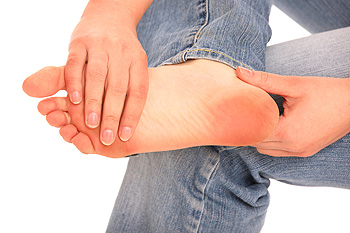 Each foot consists of several bones, ligaments, muscles, and tendons, and is considered to be one of the most complex parts of the body. When foot pain occurs, it may be a result of improper foot function that can be caused for a variety of reasons. These can consist of wearing shoes that do not fit properly, which can affect the mechanics of the feet. Additionally, genetic factors may play a significant role in existing foot pain. Heel pain can be indicative of a condition that is known as heel spurs. It is defined as a bony growth that develops underneath the heel and can cause pain and discomfort. A bunion will typically form on the bottom of the big toe and appears as a large growth. Another form of foot pain can be the result of an ankle sprain, which may occur from falling, or from stepping off of a curb unexpectedly. If you are experiencing any type of foot pain, it is suggested that you speak to a podiatrist who can properly treat any foot conditions.
Each foot consists of several bones, ligaments, muscles, and tendons, and is considered to be one of the most complex parts of the body. When foot pain occurs, it may be a result of improper foot function that can be caused for a variety of reasons. These can consist of wearing shoes that do not fit properly, which can affect the mechanics of the feet. Additionally, genetic factors may play a significant role in existing foot pain. Heel pain can be indicative of a condition that is known as heel spurs. It is defined as a bony growth that develops underneath the heel and can cause pain and discomfort. A bunion will typically form on the bottom of the big toe and appears as a large growth. Another form of foot pain can be the result of an ankle sprain, which may occur from falling, or from stepping off of a curb unexpectedly. If you are experiencing any type of foot pain, it is suggested that you speak to a podiatrist who can properly treat any foot conditions.
Foot Pain
Foot pain can be extremely painful and debilitating. If you have a foot pain, consult with Dr. Blake Zobell from Utah. Our doctor will assess your condition and provide you with quality foot and ankle treatment.
Causes
Foot pain is a very broad condition that could be caused by one or more ailments. The most common include:
- Bunions
- Hammertoes
- Plantar Fasciitis
- Bone Spurs
- Corns
- Tarsal Tunnel Syndrome
- Ingrown Toenails
- Arthritis (such as Gout, Rheumatoid, and Osteoarthritis)
- Flat Feet
- Injury (from stress fractures, broken toe, foot, ankle, Achilles tendon ruptures, and sprains)
- And more
Diagnosis
To figure out the cause of foot pain, podiatrists utilize several different methods. This can range from simple visual inspections and sensation tests to X-rays and MRI scans. Prior medical history, family medical history, and any recent physical traumatic events will all be taken into consideration for a proper diagnosis.
Treatment
Treatment depends upon the cause of the foot pain. Whether it is resting, staying off the foot, or having surgery; podiatrists have a number of treatment options available for foot pain.
If you have any questions, please feel free to contact one of our offices located in Richfield and Ephraim, Utah . We offer the newest diagnostic and treatment technologies for all your foot care needs.
Foot Pain
Our feet are arguably the most important parts of our bodies because they are responsible for getting us from place to place. However, we often don’t think about our feet until they begin to hurt. If you have pain in your feet, you need to first determine where on the foot you are experiencing it to get to the root of the problem. The most common areas to feel pain on the foot are the heel and the ankle.
Heel pain is most commonly attributed to a condition called plantar fasciitis. Plantar fasciitis occurs when the plantar fascia, which is the band of tough tissue connecting the heel bone to the toes becomes inflamed. Plantar fasciitis pain is usually worse in the morning, and it tends to go away throughout the day. If you have plantar fasciitis, you should rest your foot and do heel and foot muscles stretches. Wearing shoes with proper arch support and a cushioned sole has also been proven to be beneficial.
Some common symptoms of foot pain are redness, swelling, and stiffness. Foot pain can be dull or sharp depending on its underlying cause. Toe pain can also occur, and it is usually caused by gout, bunions, hammertoes, ingrown toenails, sprains, fractures, and corns.
If you have severe pain in your feet, you should immediately seek assistance from your podiatrist for treatment. Depending on the cause of your pain, your podiatrist may give you a variety of treatment options.
Why Live with Pain and Numbness in Your Feet?
Cuboid Syndrome
Cuboid syndrome mostly affects athletes, although it can affect non-athletes too. It is also known as cuboid subluxation or cuboid fault syndrome. This condition occurs when joints and ligaments near the cuboid bone of the foot are damaged, or when the cuboid bone itself is dislodged from its natural position. It is usually marked by pain on the outer side of the foot, which may be persistent or may come and go. Cuboid syndrome can be difficult to diagnose unless it becomes severe and more noticeable. Your doctor will likely ask questions about when the pain began and how long it has been present, and will put pressure on the cuboid bone to determine if that area is the origin of the pain.
Causes of Cuboid Syndrome
- Any repetitive stresses placed on the foot due to athletic activities are a common cause of cuboid syndrome.
- Although it develops over time, it is possible that this syndrome can occur all of sudden due to a single event or injury.
- Over-pronation can exacerbate the condition if not corrected.
Disagreements Amongst Podiatrists Regarding Cuboid Syndrome
- Some refer to it as the dislocation of the calcaneal-cuboid joint only.
- Other podiatrists see it as an injury of the ligaments located nearby, which also involves the cuboid bone.
It is very important that when you experience any kind of pain on the side of your foot, you should seek medical care right away. If a subluxed cuboid is caught early, your feet may respond well to the treatment, and you can get back into sports or other activities again as soon as the pain subsides.
Teenagers and Sever's Disease
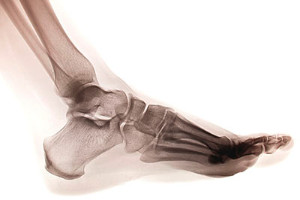 The medical condition that is referred to as Calcaneal Apophysitis is commonly known as Sever's disease. This disease occurs when the growth plate in the heel becomes swollen, and typically affects teenagers who participate in sporting activities. As growing occurs, muscles and tendons can put strain and pressure on the heel, possibly causing swelling and tenderness. An initial step in beginning treatment of this condition is to look out for high arches or flat feet that may be present. This may affect the way walking is done, and can be important to know so proper treatment techniques can begin. Mild relief may be found when gentle exercises are frequently performed that can promote mobility. Additionally, it may be beneficial to wear orthotics, as this may aid in the treatment of Sever's disease. If your child is suffering from this condition, it is strongly advised that you consult with a podiatrist who can properly diagnosis and treat this condition.
The medical condition that is referred to as Calcaneal Apophysitis is commonly known as Sever's disease. This disease occurs when the growth plate in the heel becomes swollen, and typically affects teenagers who participate in sporting activities. As growing occurs, muscles and tendons can put strain and pressure on the heel, possibly causing swelling and tenderness. An initial step in beginning treatment of this condition is to look out for high arches or flat feet that may be present. This may affect the way walking is done, and can be important to know so proper treatment techniques can begin. Mild relief may be found when gentle exercises are frequently performed that can promote mobility. Additionally, it may be beneficial to wear orthotics, as this may aid in the treatment of Sever's disease. If your child is suffering from this condition, it is strongly advised that you consult with a podiatrist who can properly diagnosis and treat this condition.
Sever's disease often occurs in children and teens. If your child is experiencing foot or ankle pain, see Dr. Blake Zobell from Utah. Our doctor can treat your child’s foot and ankle needs.
Sever’s Disease
Sever’s disease is also known as calcaneal apophysitis, which is a medical condition that causes heel pain I none or both feet. The disease is known to affect children between the ages of 8 and 14.
Sever’s disease occurs when part of the child’s heel known as the growth plate (calcaneal epiphysis) is attached to the Achilles tendon. This area can suffer injury when the muscles and tendons of the growing foot do not keep pace with bone growth. Therefore, the constant pain which one experiences at the back of the heel will make the child unable to put any weight on the heel. The child is then forced to walk on their toes.
Symptoms
Acute pain – Pain associated with Sever’s disease is usually felt in the heel when the child engages in physical activity such as walking, jumping and or running.
Highly active – Children who are very active are among the most susceptible in experiencing Sever’s disease, because of the stress and tension placed on their feet.
If you have any questions, please feel free to contact one of our offices located in Richfield and Ephraim, Utah . We offer the newest diagnostic and treatment technologies for all your foot and ankle injuries.
Sever's Disease
Sever's disease, also known as calcaneal apophysitis, is a medical condition that causes heel pain in children’s feet while they’re growing. Sever's disease occurs most commonly in boys and girls between the ages of 8 and 14.
Sever's disease occurs when the child’s growth plate, or the calcaneal epiphysis, an area attached to the Achilles tendon, is injured or when the muscles and tendons of the growing foot do not keep pace with bone growth. The result is constant pain experienced at the back of the heel and the inability to put any weight on the heel. This forces the child to bear weight on their toes while walking. When a toe gait develops, the child must change the way they walk to avoid placing weight on the painful heel. If this is not properly addressed, this can lead to further developmental problems.
The most common symptom of Sever's disease is acute pain felt in the heel when a child engages in physical activity such as walking, jumping or running. Children who are active athletes are among the group most susceptible to experiencing Sever's disease. This is due to the extreme stress and tension placed on their growing feet. The rolling movement of the foot during walking or running and obesity are both additional conditions linked to causing Sever's disease.
The first step in treating Sever's disease is to rest the foot and leg and avoid physical activity. Over the counter pain-relieving and anti-inflammatory medications can be helpful for reducing the amount of heel pain. A child with Sever's disease should also wear shoes that properly support the heel and the arch of the foot. Consider purchasing orthotic shoe inserts which can help support the heel and foot while it is healing. Most patients with Sever's disease symptoms report an eventual elimination of heel pain after wearing orthotic insoles that support the affected heel.
Sever's disease may affect either one heel or both. It is important for a child experiencing heel pain to be examined by a foot doctor who can apply the squeeze test. The squeeze test compresses both sides of the heel in order to determine if there is intense pain. Discourage any child diagnosed with Sever's disease from going barefoot as this can intensify the problem. Apply ice packs to the affected painful heel two or three times a day for pain relief.
Exercises that help stretch the calf muscles and hamstrings are effective at treating Sever's disease. An exercise known as foot curling has also proven to be very effective at treating Sever's disease. When foot curling, the foot is pointed away from the body, then curled toward the body to help stretch the muscles. The curling exercise should be done in sets of 10 or 20 repetitions and repeated several times throughout the day.
Treatment methods can continue for at least 2 weeks and as long as 2 months before the heel pain completely disappears. A child can continue doing daily stretching exercises for the legs and feet to prevent Sever’s disease from returning.
Why Do I Have Heel Pain?
 Heel pain is a common ailment among many people. It may be a foot condition that is more prevalent among specific groups of people. These may include individuals who are obese, people who participate in sporting activities, or women who are pregnant. Additionally, heel pain may develop from wearing shoes that do not fit correctly, or if there has been an injury to the heel. Patients who have medical conditions that include plantar fasciitis or heel spurs are familiar with the heel pain that is often associated with these ailments. There are methods that can be implemented which may provide moderate relief. These can consist of wearing custom made orthotics, resting the heel, and performing specific flexibility stretches. If you have any type of heel pain, it is strongly suggested that you consult with a podiatrist who can properly diagnosis and treat this condition.
Heel pain is a common ailment among many people. It may be a foot condition that is more prevalent among specific groups of people. These may include individuals who are obese, people who participate in sporting activities, or women who are pregnant. Additionally, heel pain may develop from wearing shoes that do not fit correctly, or if there has been an injury to the heel. Patients who have medical conditions that include plantar fasciitis or heel spurs are familiar with the heel pain that is often associated with these ailments. There are methods that can be implemented which may provide moderate relief. These can consist of wearing custom made orthotics, resting the heel, and performing specific flexibility stretches. If you have any type of heel pain, it is strongly suggested that you consult with a podiatrist who can properly diagnosis and treat this condition.
Many people suffer from bouts of heel pain. For more information, contact Dr. Blake Zobell of Utah. Our doctor can provide the care you need to keep you pain-free and on your feet.
Causes of Heel Pain
Heel pain is often associated with plantar fasciitis. The plantar fascia is a band of tissues that extends along the bottom of the foot. A rip or tear in this ligament can cause inflammation of the tissue.
Achilles tendonitis is another cause of heel pain. Inflammation of the Achilles tendon will cause pain from fractures and muscle tearing. Lack of flexibility is also another symptom.
Heel spurs are another cause of pain. When the tissues of the plantar fascia undergo a great deal of stress, it can lead to ligament separation from the heel bone, causing heel spurs.
Why Might Heel Pain Occur?
- Wearing ill-fitting shoes
- Wearing non-supportive shoes
- Weight change
- Excessive running
Treatments
Heel pain should be treated as soon as possible for immediate results. Keeping your feet in a stress-free environment will help. If you suffer from Achilles tendonitis or plantar fasciitis, applying ice will reduce the swelling. Stretching before an exercise like running will help the muscles. Using all these tips will help make heel pain a condition of the past.
If you have any questions please contact one of our offices located in Richfield and Ephraim, Utah . We offer the newest diagnostic and treatment technologies for all your foot and ankle needs.





